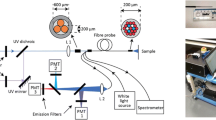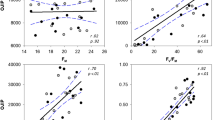Abstract
Main conclusion
Excited state lifetime-based separation of fluorophore-tagged antibiotic conjugate emission from the spectrally broad plant autofluorescence enables in planta tracking of the translocation of systemic cargo such as antibiotics via fluorescence lifetime imaging.
Abstract
The efficacy of antibiotic treatments in citrus crops is uncertain due to mixed results from in-field experiments and a lack of study on their systemic movement. As of yet there has been an inability to track treatments using traditional fluorescence microscopy due to treatments having little fluorescence characteristics, and signal convolution due to plant autofluorescence. In this study, we used streptomycin sulfate, a commercially available antibiotic, and conjugated it to a modified tris(bipyridine) ruthenium (II) chloride, a dye with an excited state lifetime magnitudes higher than other commonly used organic fluorescent probes. The resultant is a fluorescence lifetime imaging (FLIM) trackable antibiotic conjugate, covalently attached via an amide linkage that is uniquely distinguishable from plant autofluorescence. Characterization of the fluorescent antibiotic conjugate showed no mitigation of excited state lifetime, and a distinct IR peak not found in any synthetic components. Subsequent tracking using FLIM in citrus tissue was achieved, with identification of movement through citrus plant vasculature via tissue localization in xylem and phloem. Results indicated upwards systemic movement of the conjugate in both xylem and phloem after 48 h of incubation. However, the conjugate failed to move down towards the root system of the plant by 168 h. Mechanistically, it is likely that xylem contributes heavily in the translocation of the conjugate upwards; however, phloem led flow due to growth changes could act as a contributor. This proof-of-concept sets groundwork for subsequent studies regarding antibiotic localization and movement in citrus.










Similar content being viewed by others
References
Aćimović SG, Zeng Q, McGhee GC, Sundin GW, Wise JC (2015) Control of fire blight (Erwinia amylovora) on apple trees with trunk-injected plant resistance inducers and antibiotics and assessment of induction of pathogenesis-related protein genes. Front Plant Sci. https://doi.org/10.3389/fpls.2015.00016
Al-Rimawi F, Hijaz F, Nehela Y, Batuman O, Killiny N (2019) Uptake, translocation, and stability of oxytetracycline and streptomycin in citrus plants. Antibiotics. https://doi.org/10.3390/antibiotics8040196
Alvarez S, Rohrig E, Solís D, Thomas MH (2016) Citrus greening disease (Huanglongbing) in Florida: economic impact, management and the potential for biological control. Agric Res 5(2):109–118. https://doi.org/10.1007/s40003-016-0204-z
Bücherl CA, Bader A, Westphal AH, Laptenok SP, Borst JW (2014) FRET-FLIM applications in plant systems. Protoplasma 251(2):383–394. https://doi.org/10.1007/s00709-013-0595-7
Buschmann C, Langsdorf G, Lichtenthaler HK (2000) Imaging of the blue, green, and red fluorescence emission of plants: an overview. Photosynthetica 38(4):483–491. https://doi.org/10.1023/A:1012440903014
Evert RF, Eichhorn SE (2012) Raven biology of plants, 8th edn. Freeman, New York
Hall DG, Gottwald TR, Stover E, Beattie GAC (2013) Evaluation of management programs for protecting young citrus plantings from huanglongbing. HortScience 48(3):330. https://doi.org/10.21273/hortsci.48.3.330
Jasim KA, Gesquiere AJ (2019) Ultrastable and biofunctionalizable conjugated polymer nanoparticles with encapsulated iron for ferroptosis assisted chemodynamic therapy. Mol Pharm. https://doi.org/10.1021/acs.molpharmaceut.9b00737
Kalyanasundaram K (1982) Photophysics, photochemistry and solar energy conversion with tris(bipyridyl)ruthenium(II) and its analogues. Coord Chem Rev 46:159–244. https://doi.org/10.1016/0010-8545(82)85003-0
Keeler GP (2014) Ruthenium: synthesis, physicochemical properties and applications. Nova Science Pub Inc, New York
Khimich NN, Zdravkov AV, Aleksashkina MA (2004) Synthesis of ruthenium(II) tris(2,2’-bipyridine) complexes. Russ J Gen Chem 74(7):993–995. https://doi.org/10.1023/B:RUGC.0000045853.99936.aa
Kundu A, Nogueira Campos MG, Santra S, Rajaraman S (2019) Precision vascular delivery of agrochemicals with micromilled microneedles (µMMNs). Sci Rep 9(1):14008. https://doi.org/10.1038/s41598-019-50386-8
Lakowicz JR (2006) Principles of fluorescence spectroscopy, 3rd edn. Springer, New York
Lamichhane JR, Osdaghi E, Behlau F, Köhl J, Jones JB, Aubertot J-N (2018) Thirteen decades of antimicrobial copper compounds applied in agriculture A review. Agron Sustain Dev 38(3):28. https://doi.org/10.1007/s13593-018-0503-9
Larkin P (2011) Appendix—IR/Raman correlation charts. In: Larkin P (ed) Infrared and raman spectroscopy. Elsevier, Oxford, pp 213–215. https://doi.org/10.1016/B978-0-12-386984-5.10014-X
Lei R, Jiang H, Hu F, Yan J, Zhu S (2017) Chlorophyll fluorescence lifetime imaging provides new insight into the chlorosis induced by plant virus infection. Plant Cell Rep 36(2):327–341. https://doi.org/10.1007/s00299-016-2083-y
Lumpkin RS, Kober EM, Worl LA, Murtaza Z, Meyer TJ (1990) Metal-to-ligand charge-transfer (MLCT) photochemistry: experimental evidence for the participation of a higher lying MLCT state in polypyridyl complexes of ruthenium(II) and osmium(II). J Phys Chem 94(1):239–243. https://doi.org/10.1021/j100364a039
Mauseth JD (2012) Botany: an introduction to plant biology, 5th edn. Jones & Bartlett Learning, Burlington
Mayerhofer G, Schwaiger-Nemirova I, Kuhn T, Girsch L, Allerberger F (2009) Detecting streptomycin in apples from orchards treated for fire blight. J Antimicrob Chemother 63(5):1076–1077. https://doi.org/10.1093/jac/dkp055
McVay J, Sun X, Jones D, Urbina H, Aldeek F, Cook JM, Jeyaprakash A, Hodges G, Smith T (2019) Limited persistence of residues and metabolites in fruit and juice following penicillin trunk infusion in citrus affected by Huanglongbing. Crop Prot 125:104753. https://doi.org/10.1016/j.cropro.2019.03.001
Miller G, Santra S, Gesquiere A (2019) Using fluorescence lifetime imaging microscopy for tracking translocation of small molecule pesticides in citrus seedlings. Abstr Pap Am Chem Soc 257:1
Munir S, He P, Wu Y, He P, Khan S, Huang M, Cui W, He P, He Y (2018) Huanglongbing control: perhaps the end of the beginning. Microb Ecol 76(1):192–204. https://doi.org/10.1007/s00248-017-1123-7
Nakano Y, Iwasaki N (2019) Determination of phloem sap flow rate using a combination of the heat balance method and girdling in citrus. Agric For Meteorol 278:107669. https://doi.org/10.1016/j.agrformet.2019.107669
National Academies of Sciences E, Medicine (2018) A review of the citrus greening research and development efforts supported by the citrus research and development foundation. The National Academies Press, Washington DC . https://doi.org/10.17226/25026
Richardson HW (2003) Copper compounds. In: Kirk‐othmer encyclopedia of chemical technology. doi:https://doi.org/10.1002/0471238961.0315161618090308.a01.pub2
Ross MA, Lembi CA (2008) Applied weed science: including the ecology and management of invasive plants. Prentice Hall, Upper Saddle River
San Tan S, Yanagisawa S, Inagaki K, Morikawa Y, Kassim MB (2017) Augmented pH-sensitivity absorbance of a ruthenium(II) bis(bipyridine) complex with elongation of the conjugated ligands: an experimental and theoretical investigation. Phys Chem Chem Phy 19(37):25734–25745. https://doi.org/10.1039/C7CP04268J
Sehgal D, Vijay IK (1994) A method for the high efficiency of water-soluble carbodiimide-mediated amidation. Anal Biochem 218(1):87–91. https://doi.org/10.1006/abio.1994.1144
Smith BC (2011) Fundamentals of Fourier transform infrared spectroscopy, 2nd edn. CRC Press, Boca Raton
Tenery D, Worden JG, Hu Z, Gesquiere AJ (2009) Single particle spectroscopy on composite MEH-PPV/PCBM nanoparticles. J Lumin 129(5):423–429. https://doi.org/10.1016/j.jlumin.2008.11.009
Terpetschnig E, Szmacinski H, Malak H, Lakowicz JR (1995) Metal-ligand complexes as a new class of long-lived fluorophores for protein hydrodynamics. Biophys J 68(1):342–350. https://doi.org/10.1016/S0006-3495(95)80193-1
US EPA (2019) Pesticide emergency exemptions. https://www.epa.gov/pesticide-registration/pesticide-emergency-exemptions. Accessed 10 Jan 2020
Wan W, Su J (2018) Study of laser-induced plant fluorescence lifetime imaging technology for plant remote sensing monitor. Measurement 125:564–571. https://doi.org/10.1016/j.measurement.2018.05.036
Wilson M (1997) Biocontrol of aerial plant diseases in agriculture and horticulture: current approaches and future prospects. J Ind Microbiol Biotechnol 19(3):188–191. https://doi.org/10.1038/sj.jim.2900436
Acknowledgements
The authors would like to acknowledge Dr. Evan Johnson and Tony Macintosh for providing citrus saplings, Dr. Maria Campos for her help with utilizing the growth chamber, Dr. Titel Jurca for use of glassware for synthesis of the conjugate, and Dr. Matthew Rex for his assistance in running HPLC. This work was supported by the National Institute of Food and Agriculture [Grant no. 2015-70016-23010/project accession no. 1005557] from the USDA National Institute of Food and Agriculture.
Author information
Authors and Affiliations
Corresponding author
Additional information
Communicated by Anastasios Melis.
Publisher's Note
Springer Nature remains neutral with regard to jurisdictional claims in published maps and institutional affiliations.
Supplementary Information
Below is the link to the electronic supplementary material.
Rights and permissions
About this article
Cite this article
Miller, G.S., Parente, R.M., Santra, S. et al. Tracking of fluorescent antibiotic conjugate in planta utilizing fluorescence lifetime imaging. Planta 253, 62 (2021). https://doi.org/10.1007/s00425-020-03559-z
Received:
Accepted:
Published:
DOI: https://doi.org/10.1007/s00425-020-03559-z




